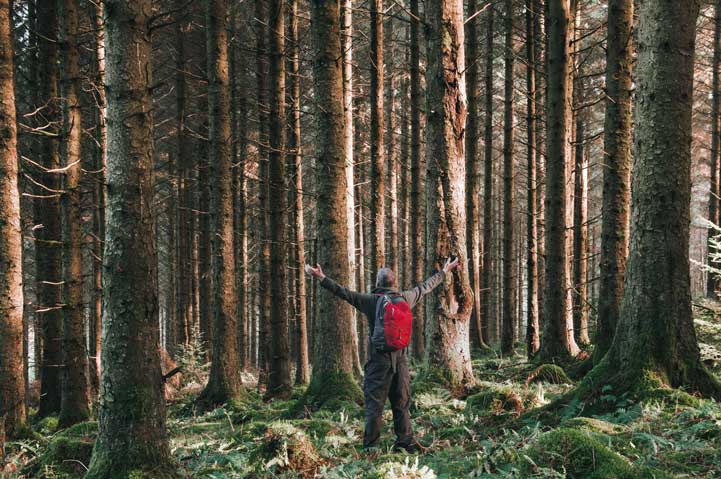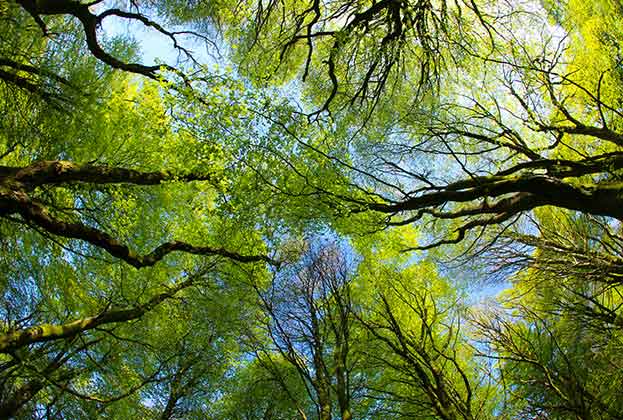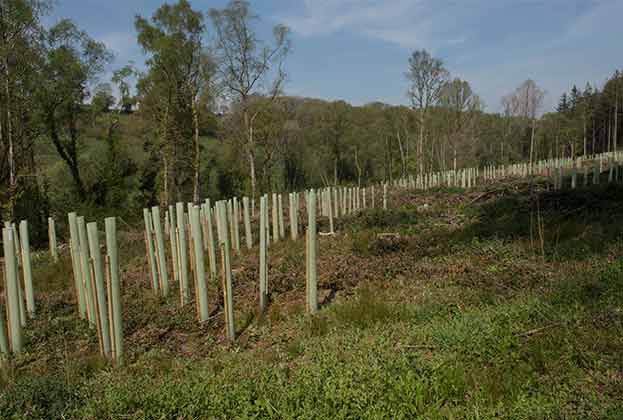With policy drivers and private market demand promoting woodland creation,we discuss what it will take to significantly increase the nation’s tree planting
The UK government has committed to ambitious tree planting, promising to reach an annual target of 30,000 hectares of new woodland creation by the end of its term, bringing goals in line with the Committee on Climate Change (CCC) net zero recommendations. The most recent ratified UK figures suggest 13,500 hectares were planted in the 12 months to March 2020, with an estimated similar, albeit slightly higher figure to March 2021. This puts current planting rates at 45% of what is required. But, exactly what is needed if we are to have any hope of achieving these goals?
Land availability
At the highest level, land availability is the most significant factor for new woodland creation. Not only does land need to be available, but it also needs to be suitable for woodland development.
Excluding valuable agricultural land and land under protected designations, the Forestry Commission has identified approximately 3.2 million hectares in England as favourable for tree planting. A similar project commissioned by the Scottish government estimated there were 2.7 million hectares of land with the “most likely potential for woodland expansion” across Scotland. Together this represents an extra 24% of the total landmass in Scotland and England that is suitable for expanding woodlands. Converting this land from its current primary use (normally farmland) is the core challenge. Land managers need to be committed to long-term change, which means that most tenanted land is likely to be excluded. A number of grant schemes exist to incentivise woodland creation, and the rising value of forestry should be a motivator in its own right.
Land use change to forestry is a complex process and can require environmental impact assessments in extreme cases. The process is also time-consuming and this has to be factored into appraisals. As a result, the process of developing a scheme can take six months to two years depending on scale, and often the net plantable area is only 40% to 60% of the overall area after deductions for safeguarding.
Labour/skills requirements
Rapid upscaling is needed if the UK is to meet its tree-planting targets. A crucial part of that upscaling revolves around the labour and skills needed to advise, plant and manage new woodland creation. A Scottish study (2019) suggested that in order to meet Scotland’s share of the 30,000-hectare commitment, it needed an uplift of 29% of the workforce over 10 years. Estimates based on the Scottish research and the planting targets indicate the shortfall could be as many as 12,500 people in England and Wales.
The Institute of Chartered Foresters believes there is an urgent need for more skilled staff in the forestry workforce even before ambitious tree-planting targets are taken into account. The Institute explained that “the necessary scale of change must be reflected in professional delivery capacity at all levels and in all settings. It will also be crucial to maintain standards to avoid damage to the environment and reputational risk to the sector.”
There are calls to make forestry and environmental studies more mainstream at school level, and build on degree apprenticeships as an opportunity to increase capacity in the sector and promote diversity in the workforce. The need for upscaling and upskilling is also a great opportunity to forge links with the wider land-use community and draw in career changers from other sectors, especially post-Covid-19.
Approximately 100 students graduate from higher education forestry courses each year across the UK. Work is being done by devolved governments to develop plans to attract talent to the sector, improve skills and technical knowledge, support education providers and employers.
Funding from schemes such as the Green Recovery Challenge Fund and Scotland’s Kickstart programme may help enable increased employment in the sector. However, there are no guarantees. Sustained political will and government commitments will be essential in delivering scale, if the UK is realistically going to achieve its net zero, biodiversity and planting targets.
Nursery capacity
With increasing planting and re-stocking demand comes even greater demand for tree seedlings. Tree nurseries have endured sustained demand increases over the last few years. The nursery sector has struggled to anticipate demand for seedlings in what is essentially a time-critical operation. Scaling up planting stock needs careful planning given the long-term nature of these ventures to avoid under or over supply.
Nurseries also need to be ready to adapt to the impact of a changing climate on seedling requirements, as there is likely to be a rising demand for seeds able to withstand increasing disease and climatic pressure and achieve desired productivity. Even the collection of seed for nursery stock is challenging, as not all years are good mast (seed production) years.
The Forestry Commission recently announced a potential Nursery Notification Scheme, intended to inform UK seed suppliers and tree growers of forthcoming woodland creation and restocking projects, in the hope that it will enable them to prepare tree stock accordingly and ensure supply across the sector.
The industry requires substantial investment if tree planting is to be delivered rapidly and at significant scale – trees don’t grow overnight
Nicola Buckingham, Associate Director, Rural Research
The forestry sector has not seen such a rapid demand for upscaling for many years, possibly ever. The turn around needed to reach net zero emissions by 2050 is at odds with a sector that has always worked on long timescales. The industry requires substantial investment if tree planting is to be delivered rapidly and at significant scale – trees don’t grow overnight.
The social power of forestry
Forestry is a multi-functional asset, with multiple ecosystem services flowing from it, whether it be timber, carbon, flood prevention or public access. Woodlands are increasingly being understood and utilised for their holistic value. Forest bathing is a practice garnering interest. It originates from Japan and focuses on immersing oneself in woodland as a way to relax, cure anxiety and improve mental health.
There is more and more science emerging into the effects of leaf shape, the colour green and the sounds and smells of a forest and the positive impact that this has on mental and physical health. Some land managers are leasing spaces within their woodland for forest bathing courses to take place, or reaping additional value by creating commercial forest therapy enterprises. As society increasingly demands the multiple benefits that flow from forestry, land managers have the chance to innovate with service lines and opportunities.

Timber market
A year on from the start of the Covid-19 pandemic and we can start to uncover the ways in which the virus has had an impact on the end-users of the timber market. During the pandemic, many home owners, bored of staring at the same four walls and with time on their hands, have taken to renovating, with sales of home improvement and gardening products growing by almost 50% compared to the previous year (Statista 2020). Much of these purchases will be timber-based building materials. However, despite the increase in DIY, housebuilding was halted for the first lockdown of 2020, disrupting demand for timber materials on a larger scale.
Finally, Covid-19 has resulted in a rapid increase in online retail – in June 2020, online retail accounted for a record 33% of all retail sales and 91 local authorities have seen parcel deliveries rise by more than 100% over the past year (Savills Research). This is likely to have resulted in an increased demand for both cardboard and timber pallets, critical to a booming delivery logistics sector.
Ultimately, promoting a high quality, high demand timber market is a key part of the solution to increasing tree planting across the UK and in doing so thereby sequestering more carbon.
Read the articles within The Forestry Market below.
.jpg)


